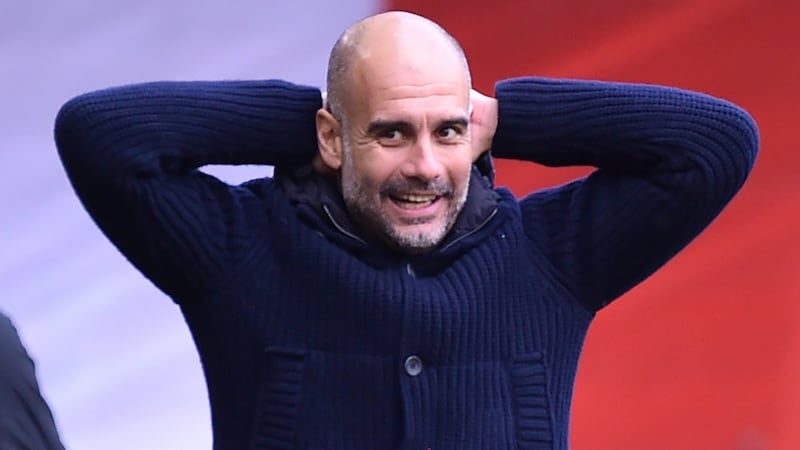Sunday's meeting of Manchester City and Liverpool is not just between the past two Premier League champions and the two favourites to win the title this season or even Pep Guardiola and Jürgen Klopp, it is also a meeting of two different modes of pressing.
The tactical centre of European football is shifting. While the four German sides lead or are level on points at the top of their Champions League groups, Spanish clubs are struggling. It is true Barcelona and Real Madrid have specific issues of politics and recruitment, but there is also something more fundamental that can't be fixed by a new president, a new coach or a new midfield. Last season was the first season since 2007 when there was no Spanish representation in the semi-finals of the Champions League; three of the coaches in the last four were German.
Pressing is not new. Since the game began, players have chased high up the pitch to try to dispossess opponents. It was in the 60s that it developed as a systematised, cohesive strategy that used an aggressive offside trap to mitigate the risk of leaving players unguarded in one part of the pitch to focus efforts elsewhere, pioneered most notably by Viktor Maslov at Dynamo Kyiv and Rinus Michels at Ajax.
The German model of pressing is not monolithic, but the influence of its various strands is profound
Michels carried the theory to Barcelona and it was taken on by Osvaldo Zubeldía in Argentina and more widely in England, underpinning Liverpool's successes of the late 70s. During the following decade, Arrigo Sacchi and Marcelo Bielsa developed their own variants.
Germany remained largely resistant, but a seed was sown in a training field near Ostfildern, south-east of Stuttgart, in February 1983 when Valeriy Lobanovskyi's Dynamo Kyiv played the local sixth-tier side, Viktoria Backnang, as part of their winter training. Viktoria's young player-manager was Ralf Rangnick and he was fascinated by the way Dynamo seemed always able to overman. He and his friend Helmut Gross, a structural engineer who had essentially taught himself tactical theory, started a movement. From their work grew the German school of today.
Until this summer Rangnick was head of sport and development at Red Bull. As such, he had a direct influence over coaches such as Julian Nagelsmann, Ralph Hasenhüttl, Marco Rose and Jesse Marsch. The improvement in Bayern's pressing last season is largely credited to Danny Röhl, an assistant coach appointed from Southampton who had worked under Rangnick at Leipzig.
One of Rangnick's fellow-thinkers in the early days was Wolfgang Frank. Drawing specific inspiration from Sacchi, he imposed pressing on a Mainz squad that included Klopp, who developed those ideas first at Mainz and then at Borussia Dortmund. Even Klopp, though, highlights a 4-1 defeat for his Dortmund to Rangnick's Hoffenheim in 2009 as an epiphany. Thomas Tuchel followed the same path from Mainz to Dortmund, while David Wagner and Daniel Farke worked at Dortmund before taking jobs in the Championship.
The German model of pressing is not monolithic, but the influence of its various strands is profound. What Guardiola did at Barcelona was radical but football evolves constantly. Ten years on, he is no longer in the vanguard.
What does it mean, though, to say that pressing has evolved? To a large degree the issue is physical. Players are quicker and stronger now – as they need to be to press efficiently, given the technical level is higher across a team – and they are also fitter: able to press essentially at full tilt for the whole game.

Guardiola’s Barça were a notably short side, his revolution made possible by a crackdown on intimidatory tackling and changes to the offside law that stretched the effective playing area. The German school, being more concerned with regaining than retaining possession, is more focused on physique than technique (which makes Klopp’s signing of Thiago Alcântara an intriguing step away).
But where the Rangnick-inspired model has really surpassed that of Barcelona is in its organisation. Klopp won't let any outsider watch his pressing sessions, his secretiveness indicative of how much of a competitive advantage he believes he derives from them. But as examples of what is possible, take the goals Naby Keïta scored against Huddersfield and Shane Long scored against Watford in 2018-19. Both stemmed from opposition kick-offs, from Liverpool and Southampton knowing where the ball was likely to be played and setting an ambush.
A kick-off is simple to analyse and it is easy to see when the plan has worked and the trap been sprung. But this sort of thing is happening constantly. Analysis reveals the internal dynamics of a side, how they tend to build play. Ideally, the press wins the ball back. Failing that, an opponent can be forced to play the ball into a particular situation where a trap may be set. But even if possession is not directly regained, pressing done well disrupts the rhythm of the opponent.
It is, though, a sophisticated and delicate mechanism – it only takes one cog to go awry for the system to collapse, as it did for Liverpool at Aston Villa last month.
Opta collates a number of metrics that offer an insight into how a team is pressing. Perhaps the most telling, at least from a City point of view, is opposition passes allowed per defensive action. In Guardiola’s first two seasons, City led that, restricting opponents to an average of 8.3 passes. Even when they allowed an average of 10.0 in 2018-19, they led the rankings. They achieved a similar figure last season, but fell behind Leicester and Southampton. This season, though, they have declined by 16 per cent and lie seventh. Liverpool, having improved over the past four years, lie second, behind Leeds, with 10.2.
That tells a story of City’s press misfiring – perhaps an issue of personnel or fatigue, physical or psychological – just as a challenge is presented to their style of play. Sunday’s game could be a key milepost in the continuing evolution of pressing. - Guardian















